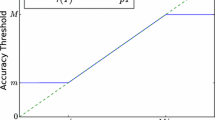Abstract
We present a statistical model for predicting the time to complete a series of successive, elective surgical cases. The use of sample means of case times and turnover times when scheduling cases does not minimize the operating room labor costs associated with errors in predicting times to complete series of cases. The problem of minimizing associated labor costs (both under and over utilization) can be converted to the problem of least absolute deviation regression. The dependent variables are the times to complete series of cases. The independent variables are the numbers of cases in each series that are in various categories (i.e., combinations of scheduled procedures and surgeons). Although the computational method is preferred on theoretical grounds to that involving sample means, application of both methods shows that the more practical method is to use the sample means of previous case times and turnovers.
Similar content being viewed by others
REFERENCES
Goldman J, Knappenberger HA, Shearon WT. A study of variability of surgical estimates. Hosp Manage 1970; 110: 46-46D
Dexter F, Macario A. Applications of information sys-tems to operating room scheduling. Anesthesiology 1996; 85: 1232-1234
Richins S, Holmes M.Waiting for satisfaction. J Healthc Manag 1998; 43: 281-285
Opit LJ, Collins REC, Campbell G. Use of operating theatres: The e¡ects of case-mix and training in general surgery. Ann RColl Surg Engl 1991; 73: 389-393
Strum DP, May JH, Vargas LG. Surgical procedure times are well modeled by the log normal distribution. Anesth Analg 1998; 86: S47
Wright IH, Kooperberg C, Bonar BA, Bashein G. Statistical modeling to predict elective surgery time: Comparison with a computer scheduling system and surgeon-provided estimates. Anesthesiology 1996; 85: 1235-1245
Macario A, Vitez TS, Dunn B, McDonald T.Where are the costs in perioperative care? Analysis of hospital costs and charges for inpatient surgical care. Anesthesiology 1995; 83: 1138-1144
Strum DP, Vargas LG, May JH, Bashein G. Surgical suite utilization and capacity planning: A minimal cost analysis model. JMed Syst 1997; 21: 309-322
Neter J, Wasserman W, Kutner MH. Applied linear statistical models, third edition. Homewood, IL: Irwin 1990; 6, 45
Hancock WM, Walter PF, More RA, Glick ND. Operat-ing room scheduling data base analysis for scheduling. JMed Syst 1998; 12: 397-409
Zhou J, Dexter F. Method to assist in the scheduling of add-on surgical cases upper prediction bounds for surgical case durations based on the log normal distribu-tion. Anesthesiology 1998; 89: 1228-1232
Narula SC. The minimum sum of absolute errors regres-sion. J Qual Tech 1987; 19: 37-45
Ye Y. Solving large-scale sparse semi-de¢nite programs for combinatorial optimization (working paper). Depart-ment of Management Sciences, University of Iowa, 1997
Staudte RG, Sheather SJ. Robust estimation and testing. NewYork: JohnWiley & Sons, 1990; 105, 119, 120 Dexter et al: Comparison of StatisticalMethods to Predict theTime to Complete a Series of Surgical Cases 51
Author information
Authors and Affiliations
Rights and permissions
About this article
Cite this article
Dexter, F., Traub, R.D. & Qian, F. Comparison of Statistical Methods to Predict the Time to Complete a Series of Surgical Cases. J Clin Monit Comput 15, 45–51 (1999). https://doi.org/10.1023/A:1009999830753
Issue Date:
DOI: https://doi.org/10.1023/A:1009999830753




